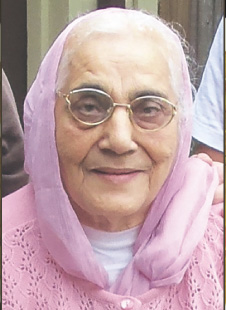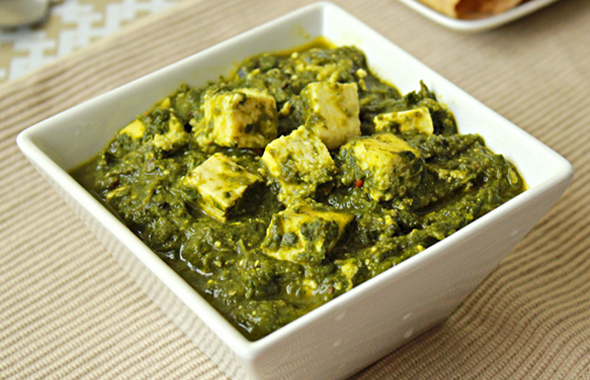Mama’s Punjabi Recipes Palak or Saag Paneer (Spinach & Indian Cheese)
There is probably no other Punjabi dish more popular worldwide than palak paneer also known as saag paneer. It can be found in any restaurant that serves North Indian food just about anywhere you go and what’s both pleasantly surprising and pleasing is how kids of all ages eagerly go straight to this vegetarian dish. But many restaurants, especially outside of India, make it with lots of white cream, which gives the dish a sweet taste and bloats the stomach. A true saag paneer has very little cream, isn’t stringy, has a slight taste of sauteed onions and has to be served hot.
The dish is made of leafy green spinach, which is rich in vitamins A, B2, B6, C, E, K, magnesium, folate, manganese, iron, calcium and potassium. It’s a very good source of protein, phosphorus, zinc, dietary fiber, and copper as well as selenium, niacin, and omega-3 fatty acids. It is really a healthy dish if made without the cream.
The paneer is an unaged, acid-set, non-melting farmer cheese made by curdling hot milk with lemon juice or vinegar to separate the whey. Many people buy the ready made paneer, even in India, although it is quite simple but time consuming to make. I have found that here, in the South, the Central American round wheel of cottage cheese made the El Salvador style is very similar to Indian paneer, only it has salt in it.
The dish made with fresh spinach leaves is tastiest, but many people also make it with cut frozen spinach, avoiding the frozen whole leaf type as the dish comes out very stringy.
Ingredients:
• 500 gm palak (spinach)
• 250 gm paneer (Indian cheese)
• 1 tablespoon atta (bleached or wheat flour)
• 1 small pyaaz (onion) – peeled and finely chopped
• ½ teaspoon of lasan (garlic) powder (if desired)
• 1 small piece of adrak (ginger) peeled and finely chopped
• 2 tablespoons of vegetable or olive oil
• Spices (to taste): namak (salt), mirch (red pepper)
Directions:
1. Carefully wash the spinach leaves thoroughly to remove any dirt, drip to dry then cut the leaves into half inch pieces.
2. Cut the paneer into 1 inch cubes. In the old days people used to stir-fry the paneer, but I have found that this only makes the paneer hard. If you like, you can slightly brown the paneer on a skillet or tava.
3. Throw the spinach into a medium pot and bring to a boil. Drain the water and then mash the spinach well, but do not liquefy it. Throw in the flour and mix well so that the spinach and liquid are not separated.
4. Heat the oil in a saucepan and when hot, throw in the onions, ginger and garlic and stir-fry till slightly brown.
5. Add the spinach puree and stir-fry for a few minutes, then add the cubes of paneer and cook for 3 more minutes. Add salt and pepper to taste and let the dish simmer for 10 minutes on very low heat.
6. When the dish is ready, the paneer will turn slightly green. Stir carefully so as not to break the paneer. The dish is ready to eat, usually with roti or any variety of bread.
Ghar ka Paneer (Homemade Indian Cheese)
Making homemade paneer is quite simple, but many young people outside of India don’t know how to make it, so this age-old recipe may be interesting for them. If you make the paneer, you can use it in the saag paneer dish, or any of a number of other dishes.
Ingredients:
• 1 liter doodh (whole milk)
• 2 tablespoons sirka (white vinegar)
Directions:
1. Bring the milk to a boil, then add the vinegar and stir well. The milk will at once separate – the water to one side and the paneer to the other.
2. If you prefer, you can use 2 tablespoons of lemon juice instead of vinegar or even a cup of sour yogurt. If you use yogurt, you will get more paneer from the milk.
3. Carefully drain the water by pouring it over a thin cheese cotton or muslin cloth to catch the paneer. It is best to place the cloth over another bowl and tie or hold down as it will become heavy with the paneer that flows out.
4. Once the water is drain and the paneer is caught, tie the cloth in a bunch at top so that the paneer forms into a ball. Let the cloth drain on a peg, about 20 minutes.
5. Take the ball off the peg, then place a heavy cutting board on top to flatten it into a ½ inch pancake. You may need to place another heavy object on top. Leave for 2 hours or overnight.
6. Remove the cloth and then cut the paneer into cubes. It is now ready to use.
 Shakuntla Malhotra is a skilled cook of Punjabi dishes made in the old-fashioned style that she learnt as a young woman in her ancestral home in Lyallpur, India before it became part of Pakistan after the Partition in 1947. People have often admired her cooking for its simplicity and taste that comes with each mouthful. Even in her mid-eighties, she continues to cook daily and agreed to share some of her delectable Punjabi recipes.
Shakuntla Malhotra is a skilled cook of Punjabi dishes made in the old-fashioned style that she learnt as a young woman in her ancestral home in Lyallpur, India before it became part of Pakistan after the Partition in 1947. People have often admired her cooking for its simplicity and taste that comes with each mouthful. Even in her mid-eighties, she continues to cook daily and agreed to share some of her delectable Punjabi recipes. 
